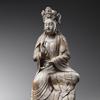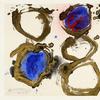Florence's Palazzo Strozzi Launches New Digital Project IN TOUCH to Reach a Global Audience in Uncertain Times
- FLORENCE, Italy
- /
- March 12, 2020
Cultural institutions are currently facing an unusual challenge: the disappearance of the direct interaction with works of art that normally lies at the very heart of the work they do.
Palazzo Strozzi in Florence, following the Italian government’s decree that the country go into preventative isolation to slow the spread of COVID-19 until the 4th of April, will launch a digital platform to explore the urgent questions about building the future, living in harmony with the natural world, and taking responsibility for the strength of our global connections which Argentinian artist Tomás Saraceno proposes in his exhibition, Aria.
The new initiative, ‘IN TOUCH’ will see the Palazzo Strozzi website become a public platform for words, images, videos, stories and further reading open to all, creating a new interaction with international audiences and triggering a debate stemming from Saraceno’s wide-reaching interrogation of our relationship with the environment.
This morning, Director Arturo Galansino published the first article of many – beginning with an introduction to IN TOUCH exploring the parallels between Saraceno’s work and the unprecedented situation that Italy and the wider world is currently experiencing.
This new project takes its cue from the museum's new major solo exhibition, Tomás Saraceno. Aria which invites talk about possible presents and futures, about connection and isolation, about participation and meditation: a more topical debate than ever to allow us to promote new visions of the future and of reality.
The first contribution of this new project is an essay entitled Like in a spiderweb by Arturo Galansino, Palazzo Strozzi Director and curator of the exhibition.
LIKE IN A SPIDER WEB by Arturo Galansino (excerpt below)
Palazzo Strozzi, like any cultural institution that wants to speak to its own time, is committed to dealing with the most relevant issues of the present. Each contemporary art exhibition thus, becomes an opportunity to investigate the world in which we live through the sensitive gaze of the artists.
The exhibition Tomás Saraceno. Aria presents a series of imaginary and utopian ‘futures’ throughout our exhibition spaces – at once hypothetical and extremely true and present. These visions are of harmony and balance, a world in which connections are clear and cooperation is necessary.
Today, in light of the situation we are experiencing, the artist's installations speak to us with an even greater strength and heightened awareness, their messages echoing through the empty rooms.
This moment of emergency leads us to reflect on our lifestyle, on the weight of our actions and on the fragility of our world. We are immersed in a hyper‐connected reality, virtually and physically, and if we were to visualise our connections and social interactions or the routes of our movements we could effectively think about the image of a spider web. We are so much part of this structure that we do not even realize it, and we open our eyes only when it is threatened or runs the risk of breaking.
Today it becomes very clear that the hyperconnection and hypermobility associated with individualism have played a significant role in aggravating the situation we are experiencing.
According to the famous "butterfly effect", coined in 1962 by the mathematician and meteorologist Edward Lorenz, the flapping of a butterfly's wings in Brazil can cause a tornado in Texas. In more concrete terms, a small action can reverberate and cause far greater effects. So let's think about the vibration of a thread, a simple touch. When this is connected to a larger structure, the whole system can vibrate, oscillate, break. If connections are threatened in any way, the damages to the entire complex can be enormous.
How can you exist in a balanced way in this hyper‐connected reality? How can risks can be limited? The path indicated by Tomás Saraceno is one of harmony. In whatever future we want to live in, we humans must learn to live symbiotically with all other beings, living and non‐living, human and non‐human. The search for a dynamic balance must become our goal, our reason for being. To achieve this, it is necessary to cooperate, making individual gestures and actions that don’t betray the common good but move in a mutually beneficial, collective direction.
Some events can disturb the balance, threatening our world. In these cases everyone is responsible for helping to maintain the balance. Every action causes a reaction, be it good or bad. As in a close‐knit orchestra, when each musician plays their part, the result is harmony: a unitary response made up of many individuals, distinct but united.
We have to be aware of our behaviors, our relationships, our movements, and the consequences they can have on others. This awareness must take place not only for our individual good, but for the good of everyone.
As in a spider web, we are small knots, part of an infinitely larger twine in which, through a chain of actions and reactions, each of our gestures makes the entire system vibrate. We must be conscious, and capable, of making it resonate in the most harmonious way possible. We must become a harmonious network in which each individual is an essential part.
In the coming weeks we will continue to champion these visions of a possible future reality outlined by Tomás Saraceno. We will do it in new ways, at a distance, hoping to stimulate a moment of reflection through the language we know best, that of art.
Lamps and lightbulbs, allies in the daily hunt, connecting ways of life in entangled dependency. Nature seems to prefer relationships to individual actions, nothing is created in isolation. Ask yourself how many multitudes you contain.
- SYM(BIO) POETICS: Card n.3 Arachnomancy


270x400_c.jpg)

100x100_c.jpg)









![Peter Paul Rubens (Flemish, 1577–1640), After Titian (Tiziano Vecelli) (Italian [Venetian], c. 1488–1576), Rape of Europa, 1628–29. Oil on canvas, 71 7/8 x 79 3/8 in. Peter Paul Rubens (Flemish, 1577–1640), After Titian (Tiziano Vecelli) (Italian [Venetian], c. 1488–1576), Rape of Europa, 1628–29. Oil on canvas, 71 7/8 x 79 3/8 in.](/images/c/e2/2e/Jan20_Rape_of_Europa100x100_c.jpg)




